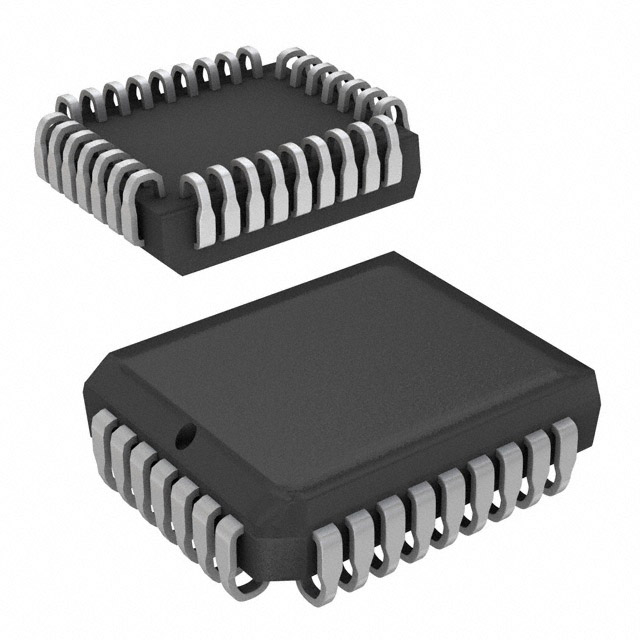AT28BV64-30JI
Product Overview
Category
AT28BV64-30JI belongs to the category of non-volatile memory devices.
Use
This product is primarily used for data storage in various electronic devices such as microcontrollers, embedded systems, and consumer electronics.
Characteristics
- Non-volatile: The AT28BV64-30JI retains stored data even when power is removed.
- High capacity: It has a storage capacity of 64 kilobits (8 kilobytes).
- Low power consumption: The device operates at low power levels, making it suitable for battery-powered applications.
- Fast access time: With a maximum access time of 30 nanoseconds, it provides quick data retrieval.
Package
The AT28BV64-30JI is available in a 32-pin PLCC (Plastic Leaded Chip Carrier) package.
Essence
The essence of this product lies in its ability to store and retrieve data reliably, even in the absence of power.
Packaging/Quantity
The AT28BV64-30JI is typically packaged in reels or tubes, with quantities varying based on customer requirements.
Specifications
- Memory Type: EEPROM (Electrically Erasable Programmable Read-Only Memory)
- Organization: 8 kilobytes x 8 bits
- Supply Voltage: 2.7V - 3.6V
- Operating Temperature Range: -40°C to +85°C
- Data Retention: 10 years
- Endurance: 100,000 write cycles
Detailed Pin Configuration
The AT28BV64-30JI has a total of 32 pins, each serving a specific purpose. The pin configuration is as follows:
- A0 - Address Input
- A1 - Address Input
- A2 - Address Input
- A3 - Address Input
- A4 - Address Input
- A5 - Address Input
- A6 - Address Input
- A7 - Address Input
- VCC - Power Supply
- OE - Output Enable
- CE - Chip Enable
- WE - Write Enable
- I/O0 - Data Input/Output
- I/O1 - Data Input/Output
- I/O2 - Data Input/Output
- I/O3 - Data Input/Output
- I/O4 - Data Input/Output
- I/O5 - Data Input/Output
- I/O6 - Data Input/Output
- I/O7 - Data Input/Output
- NC - No Connection
- GND - Ground
- NC - No Connection
- NC - No Connection
- NC - No Connection
- NC - No Connection
- NC - No Connection
- NC - No Connection
- NC - No Connection
- NC - No Connection
- NC - No Connection
- NC - No Connection
Functional Features
- Byte-wise Read and Write: The AT28BV64-30JI allows individual byte-level read and write operations, providing flexibility in data manipulation.
- Hardware Data Protection: The device features a hardware protection mechanism to prevent accidental writes, ensuring data integrity.
- Software Write Protection: It supports software-based write protection, allowing specific memory areas to be protected from modification.
Advantages and Disadvantages
Advantages
- Non-volatile nature ensures data retention even during power loss.
- High storage capacity for various applications.
- Low power consumption extends battery life.
- Fast access time enables quick data retrieval.
Disadvantages
- Limited endurance of 100,000 write cycles may pose limitations in certain high-write applications.
- Relatively higher cost compared to other memory technologies.
Working Principles
The AT28BV64-30JI utilizes EEPROM technology, which allows for electrically erasing and reprogramming of data. It consists of a grid of memory cells, each capable of storing one bit of information. The device uses electrical signals to control the read, write, and erase operations on these memory cells.
During a read operation, the desired memory location is selected by providing the appropriate address inputs. The data stored at that location is then outputted through the data input/output pins.
For a write operation, the chip enable (CE), write enable (WE), and address inputs are used to select the target memory location. The data to be written is applied to the data input/output pins, and upon receiving the necessary control signals, the device stores the data in the specified location.
To erase data, the entire memory array or specific sectors can be erased using dedicated commands. This process involves applying specific voltage levels and timing sequences to ensure the removal of previously stored data.
Detailed Application Field Plans
The AT28BV64-30JI finds applications in various fields, including but
Senaraikan 10 soalan dan jawapan biasa yang berkaitan dengan aplikasi AT28BV64-30JI dalam penyelesaian teknikal
Sure! Here are 10 common questions and answers related to the application of AT28BV64-30JI in technical solutions:
Q: What is the AT28BV64-30JI? A: The AT28BV64-30JI is a 64K (8K x 8) EEPROM (Electrically Erasable Programmable Read-Only Memory) chip manufactured by Microchip Technology.
Q: What is the operating voltage range for the AT28BV64-30JI? A: The AT28BV64-30JI operates within a voltage range of 2.7V to 3.6V.
Q: How much data can the AT28BV64-30JI store? A: The AT28BV64-30JI has a storage capacity of 64 kilobits, which is equivalent to 8 kilobytes.
Q: Can the AT28BV64-30JI be reprogrammed? A: Yes, the AT28BV64-30JI is an EEPROM, which means it can be electrically erased and reprogrammed multiple times.
Q: What is the maximum clock frequency supported by the AT28BV64-30JI? A: The AT28BV64-30JI supports a maximum clock frequency of 30 MHz.
Q: What is the access time of the AT28BV64-30JI? A: The AT28BV64-30JI has an access time of 120 ns, meaning it takes 120 nanoseconds to read or write data.
Q: Does the AT28BV64-30JI have any security features? A: Yes, the AT28BV64-30JI supports software and hardware data protection mechanisms to prevent unauthorized access.
Q: Can the AT28BV64-30JI operate in extreme temperatures? A: Yes, the AT28BV64-30JI is designed to operate within a temperature range of -40°C to +85°C.
Q: What interface does the AT28BV64-30JI use for communication? A: The AT28BV64-30JI uses a standard 8-bit parallel interface for data transfer.
Q: What are some common applications of the AT28BV64-30JI? A: The AT28BV64-30JI is commonly used in various technical solutions such as embedded systems, industrial control systems, automotive electronics, and consumer electronics where non-volatile memory storage is required.
Please note that these answers are general and may vary depending on specific requirements and use cases.


